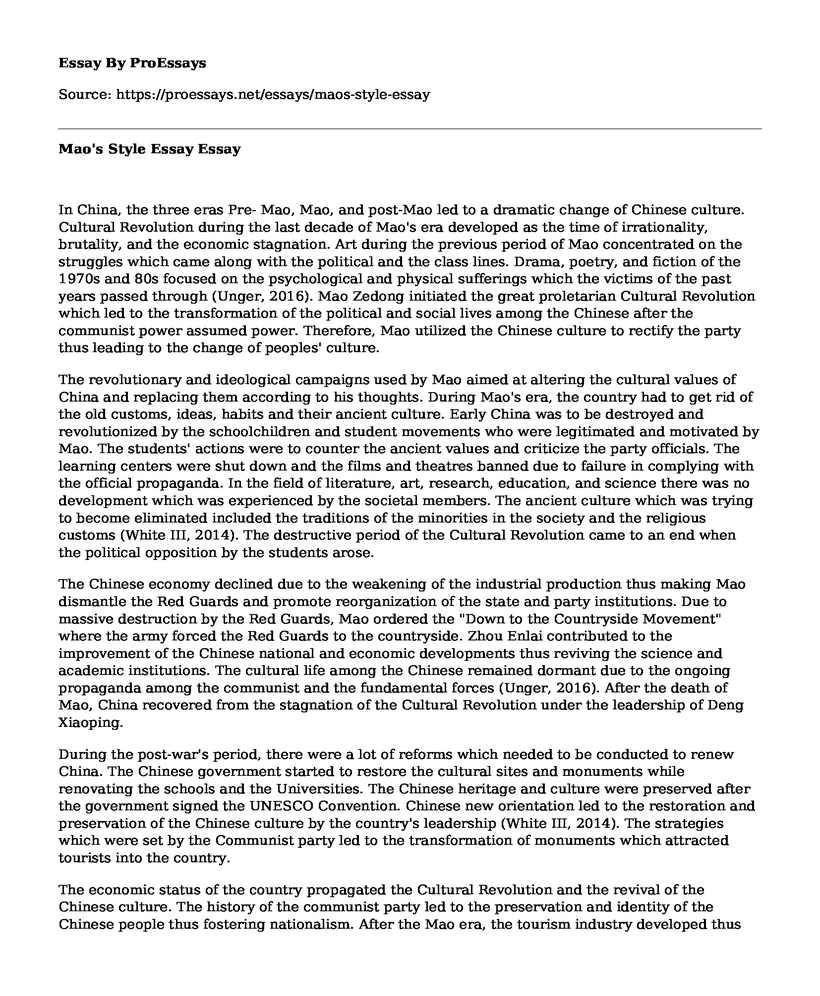In China, the three eras Pre- Mao, Mao, and post-Mao led to a dramatic change of Chinese culture. Cultural Revolution during the last decade of Mao's era developed as the time of irrationality, brutality, and the economic stagnation. Art during the previous period of Mao concentrated on the struggles which came along with the political and the class lines. Drama, poetry, and fiction of the 1970s and 80s focused on the psychological and physical sufferings which the victims of the past years passed through (Unger, 2016). Mao Zedong initiated the great proletarian Cultural Revolution which led to the transformation of the political and social lives among the Chinese after the communist power assumed power. Therefore, Mao utilized the Chinese culture to rectify the party thus leading to the change of peoples' culture.
The revolutionary and ideological campaigns used by Mao aimed at altering the cultural values of China and replacing them according to his thoughts. During Mao's era, the country had to get rid of the old customs, ideas, habits and their ancient culture. Early China was to be destroyed and revolutionized by the schoolchildren and student movements who were legitimated and motivated by Mao. The students' actions were to counter the ancient values and criticize the party officials. The learning centers were shut down and the films and theatres banned due to failure in complying with the official propaganda. In the field of literature, art, research, education, and science there was no development which was experienced by the societal members. The ancient culture which was trying to become eliminated included the traditions of the minorities in the society and the religious customs (White III, 2014). The destructive period of the Cultural Revolution came to an end when the political opposition by the students arose.
The Chinese economy declined due to the weakening of the industrial production thus making Mao dismantle the Red Guards and promote reorganization of the state and party institutions. Due to massive destruction by the Red Guards, Mao ordered the "Down to the Countryside Movement" where the army forced the Red Guards to the countryside. Zhou Enlai contributed to the improvement of the Chinese national and economic developments thus reviving the science and academic institutions. The cultural life among the Chinese remained dormant due to the ongoing propaganda among the communist and the fundamental forces (Unger, 2016). After the death of Mao, China recovered from the stagnation of the Cultural Revolution under the leadership of Deng Xiaoping.
During the post-war's period, there were a lot of reforms which needed to be conducted to renew China. The Chinese government started to restore the cultural sites and monuments while renovating the schools and the Universities. The Chinese heritage and culture were preserved after the government signed the UNESCO Convention. Chinese new orientation led to the restoration and preservation of the Chinese culture by the country's leadership (White III, 2014). The strategies which were set by the Communist party led to the transformation of monuments which attracted tourists into the country.
The economic status of the country propagated the Cultural Revolution and the revival of the Chinese culture. The history of the communist party led to the preservation and identity of the Chinese people thus fostering nationalism. After the Mao era, the tourism industry developed thus promoting the Chinese culture. Therefore, Mao's post- era led to the development of the country's culture thus helping the generation of the economic profit.
References
Unger, J. (2016). The transformation of rural China. Routledge. Retrieved from https://www.taylorfrancis.com/books/9781315292052
White III, L. T. (2014). Policies of Chaos: The Organizational Causes of Violence in China's Cultural Revolution (Vol. 1031). Princeton University Press. Retrieved from https://trove.nla.gov.au/work/18626297?selectedversion=NBD5905986
Cite this page
Mao's Style Essay. (2022, Mar 11). Retrieved from https://proessays.net/essays/maos-style-essay
If you are the original author of this essay and no longer wish to have it published on the ProEssays website, please click below to request its removal:
- Personal Essay Example: Identity and Socialization
- Essay Example on Native Reaction to Invasion of America: 1892 vs 1992
- Essay Sample on Native Americans & Europeans: Conflict, Trade & Geography
- Essay Example on Exploring Racism & Culture: A Movie About American Diversity
- Essay Example on My Mother, Mariam: A Life of Service and Dedication
- Paper on Grandma and Me: Baking Our Way to Connection
- Women's Sickness: Impact of Fundamental Family Levels on Emotions - Essay Sample







